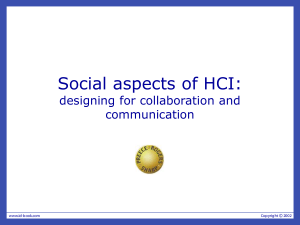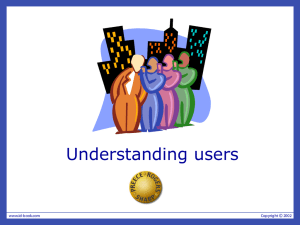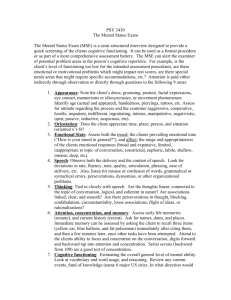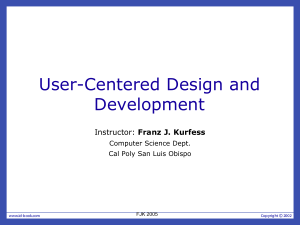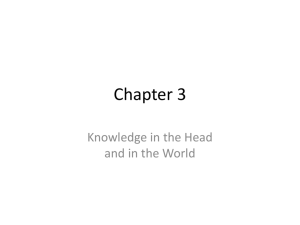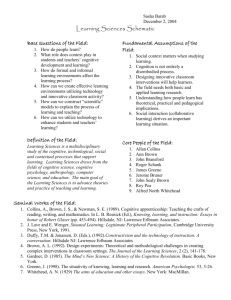Conceptual design: mental models and interface metaphors
advertisement
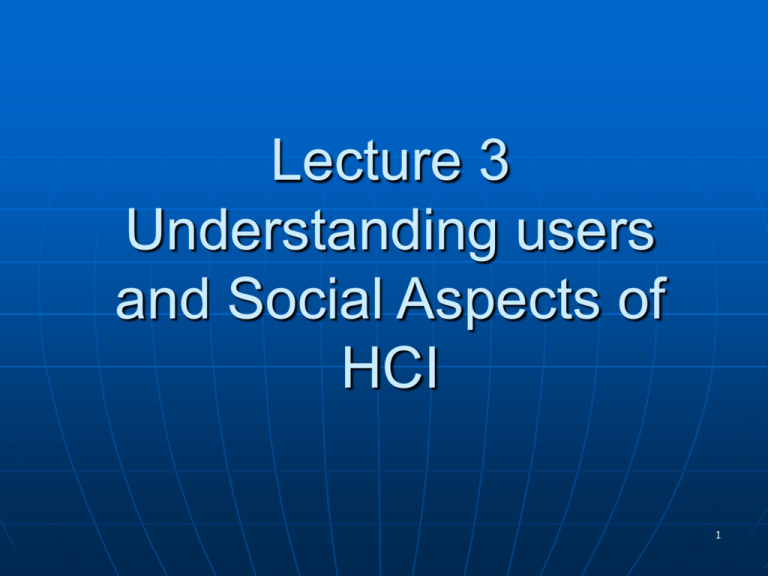
Lecture 3 Understanding users and Social Aspects of HCI 1 Overview What is cognition? • What goes on in our heads when we carry out our daily activities. What are users good and bad at? Mental models External cognition Using this understanding to inform system design 2 Why do we need to understand users? Interacting with technology is cognitive We need to take into account cognitive processes involved and cognitive limitations of users We can provide knowledge about what users can and cannot be expected to do Identify and explain the nature and causes of problems users encounter Supply theories, modelling tools, guidance and methods that can lead to the design of better interactive products 3 1. Bringing cognitive psychology knowledge to HCI What goes on in the mind? perceiving.. thinking.. remembering.. learning.. planning a meal imagining a trip painting writing composing understanding others talking with others manipulating others making decisions solving problems daydreaming... 4 Core cognitive aspects Attention Perception and recognition Memory Reading, speaking and listening Problem-solving, planning, reasoning and decision-making, learning Here we focus on attention, perception & recognition, & memory 5 Attention Selecting things to concentrate on from the mass around us, at a point in time Focussed and divided attention enables us to be selective in terms of the mass of competing stimuli but limits our ability to keep track of all events Information at the interface should be structured to capture users’ attention, e.g. use perceptual boundaries (windows), colour, reverse video, sound and flashing lights 6 Design implications for attention Make information salient when it needs attending to Use techniques that make things stand out like colour, ordering, spacing, underlining, sequencing and animation Avoid cluttering the interface - follow the google.com example of crisp, simple design Avoid using too much because the software allows it 7 An example of over-use of graphics 8 Perception and recognition How information is acquired from the world and transformed into experiences Obvious implication is to design representations that are readily perceivable, e.g. • Text should be legible • Icons should be easy to distinguish and read 9 Which is easiest to read and why? What is the time? What is the time? What is the time? What is the time? What is the time? 10 Memory Involves encoding and recalling knowledge and acting appropriately We don’t remember everything - involves filtering and processing Context is important in affecting our memory We recognize things much better than being able to recall things • The rise of the GUI over command-based interfaces Better at remembering images than words • The use of icons rather than names 11 The problem with the classic ‘72’ George Miller’s theory of how much information people can remember People’s immediate memory capacity is very limited Many designers have been led to believe that this is useful finding for interaction design 12 What some designers get up to… Present only 7 options on a menu Display only 7 icons on a tool bar Have no more than 7 bullets in a list Place only 7 items on a pull down menu Place only 7 tabs on the top of a website page • But this is wrong? Why? 13 Why? Inappropriate application of the theory People can scan lists of bullets, tabs, menu items till they see the one they want They don’t have to recall them from memory having only briefly heard or seen them Sometimes a small number of items is good design But it depends on task and available screen estate 14 More appropriate application of memory research File management and retrieval is a real problem to most users Research on information retrieval can be usefully applied Memory involves 2 processes • recall-directed: using memorized information • recognition-based scanning: by searching and recognition File management systems should be designed to optimize both kinds of memory processes 15 File management Facilitate existing memory strategies and try to assist users when they get stuck Help users encode files in richer ways • Provide them with ways of saving files using colour, flagging, image, flexible text, time stamping, etc 16 Mental models Users develop an understanding of a system through learning & using it Knowledge is often described as a mental model • How to use the system (what to do next) • What to do with unfamiliar systems or unexpected situations (how the system works) People make inferences using mental models of how to carry out tasks 17 Mental models Craik (1943) described mental models as internal constructions of some aspect of the external world enabling predictions to be made Involves unconscious and conscious processes, where images and analogies are activated Deep versus shallow models (e.g. how to drive a car and how it works) 18 Everyday reasoning & mental models (a) You arrive home on a cold winter’s night to a cold house. How do you get the house to warm up as quickly as possible? Set the thermostat to be at its highest or to the desired temperature? (b) You arrive home starving hungry. You look in the fridge and find all that is left is an uncooked pizza. You have an electric oven. Do you warm it up to 375 degrees first and then put it in (as specified by the instructions) or turn the oven up higher to try to warm it up quicker? 19 Heating up a room or oven that is thermostat-controlled Many people have erroneous mental models (Kempton, 1996) Why? • General valve theory, where ‘more is more’ principle is generalised to different settings (e.g. gas pedal, gas cooker, tap, radio volume) • Thermostats based on model of on-off switch model 20 Heating up a room or oven that is thermostat-controlled Same is often true for understanding how interactive devices and computers work: • Poor, often incomplete, easily confusable, based on inappropriate analogies and superstition (Norman, 1983) • e.g. frozen cursor/screen - most people will bash all manner of keys 21 Exercise: ATMs Write down how an ATM works • How much money are you allowed to take out? • What denominations? • If you went to another machine and tried the same what would happen? • What information is on the strip on your card? How is this used? • What happens if you enter the wrong number? • Why are there pauses between the steps of a transaction? What happens if you try to type during them? • Why does the card stay inside the machine? • Do you count the money? Why? 22 How did you fare? Your mental model • How accurate? • How similar? • How shallow? Payne (1991) did a similar study and found that people frequently resort to analogies to explain how they work People’s accounts greatly varied and were often ad hoc 23 External cognition Concerned with explaining how we interact with external representations (e.g. maps, notes, diagrams) What are the cognitive benefits and what processes involved How they extend our cognition What computer-based representations can we develop to help even more? 24 Externalizing to reduce memory load Diaries, reminders,calendars, notes, shopping lists, to-do lists - written to remind us of what to do Post-its, piles, marked emails - where placed indicates priority of what to do External representations: • Remind us that we need to do something (e.g. to buy something for mother’s day) • Remind us of what to do (e.g. buy a card) • Remind us when to do something (e.g. send a card by a certain date) 25 Computational offloading When a tool is used in conjunction with an external representation to carry out a computation (e.g. pen and paper) Try doing the two sums below (a) in your head, (b) on a piece of paper and c) with a calculator. • 234 x 456 =?? • CCXXXIIII x CCCCXXXXXVI = ??? Which is easiest and why? Both are identical sums 26 Annotation and cognitive tracing Annotation involves modifying existing representations through making marks • e.g. crossing off, ticking, underlining Cognitive tracing involves externally manipulating items into different orders or structures • e.g. playing scrabble, playing cards 27 Design implication Provide external representations at the interface that reduce memory load and facilitate computational offloading e.g. Information visualizations have been designed to allow people to make sense and rapid decisions about masses of data 28 Informing design based on our understanding of users How can we use knowledge about users to inform system design? Provide guidance and tools • Design principles and concepts • Design rules Provide analytic tools • Methods for evaluating usability 29 Mental models & system design Notion of mental models has been used as a basis for conceptual models Assumption is that if you can understand how people develop mental models then can help them develop more appropriate mental models of system functionality For example, a design principle is to try to make systems transparent so people can understand them better and know what to do 30 The design principle of transparency • NOT to be understood as literal • useful feedback • easy to understand • intuitive to use • clear & easy to follow instructions • appropriate online help • context sensitive guidance of how to proceed when stuck 31 Key points Cognition involves many processes including attention, memory, perception and learning The way an interface is designed can greatly affect how well users can perceive, attend, learn and remember how to do their tasks The conceptual framework of ‘mental models’ and ‘external cognition’ provide ways of understanding how and why people interact with products, which can lead to thinking about how to design better products 32 Social aspects of HCI: designing for collaboration and communication 33 Overview Conversation with others Awareness of others How to support people to be able to: • talk and socialise • work together • play and learn together 34 Conversation with others Various mechanisms and ‘rules’ we follow to hold a conversation • mutual greetings A: B: C: A: C: A: C: B: Hi there Hi! Hi All right? Good, How’s it going? Fine, how are you? OK So-so. How’s life treating you? 35 Conversational rules turn-taking to coordinate conversation • A: Shall we meet at 8? • B: Um, can we meet a bit later? • • • • A: B: A: B: Shall we meet at 8? Wow, look at him? Yes what a funny hairdo! Um, can we meet a bit later? Back channeling to signal to continue and following • Uh-uh, umm, ahh 36 More conversational rules farewell rituals • Bye then, see you, good-bye, see you later…. implicit and explicit cues • e.g. looking at watch, fidgeting with coat and bags • explicitly saying “Oh dear, must go, look at the time, I’m late…” 37 Breakdowns in conversation When someone says something that is misunderstood • Speaker will repeat with emphasis: A: “this one?” B: “no, I meant that one!” • Also use tokens: Eh? Quoi? Huh? What? 38 What happens in technologymediated conversations? Do same conversational rules apply? Are there more breakdowns? How do people repair them? • Phone? • Email? • Instant messaging • SMS texting? 39 Design implications How to support conversations when people are ‘at a distance’ from each other Many applications have been developed • Email, videoconferencing, videophones, computer conferencing, instant messaging, chatrooms, collaborative virtual environments, media spaces • How effective are they? Do they mimic or extend existing ways of conversing? 40 Synchronous computer-mediated communication Conversations are supported in real-time through voice and/or typing Examples include video conferencing and chatrooms Benefits • Can keep more informed of what is going on • Video conferencing allows everyone to see each other providing some support for non-verbal communication • Chatrooms can provide a forum for shy people to talk more Problems: • Video lacks bandwidth so judders and lots of shadows • Difficult to establish eye contact with images of others • People can behave badly when behind the mask of an avatar 41 Will video be a success using G3 mobile phones? • Will the judder, sudden jerks and shadows disappear? • Will it be possible to establish eye contact and read lips on such a small image? • Will people find it socially acceptable to talk to an image of someone in the palm of their hands? The VP-210" VisualPhone: a mobile video phone developed by the japanese company Kyocera Corporation Source: http://www.kyocera.co.jp/news/1999/9905/0003-e.asp 42 Asynchronous communication Communication takes place remotely at different times Email, newsgroups, computer conferencing Benefits include: • • • • Read any place any time Flexible as to how to deal with it Powerful, can send to many people Can make saying things easier Problems include: • • • • FLAMING!!! Spamming Message overload False expectations as to when people will reply 43 New communication technologies Move beyond trying to support face-toface communication Provide novel ways of interacting and talking Examples include: • • • • SMS texting via mobile phones Online chatting in chatrooms Collaborative virtual environments Media spaces 44 Collaborative virtual environments The rooftop garden in BowieWorld, a Collaborative Virtual environment (CVE), supported by Worlds.com. Users take part by “dressing up” as an avatar. There are 100s of avatars to choose from, including penguins and real persons. Once an avatar has entered a world they can explore it and chat to other avatars. Source: www.worlds.com/bowie 45 VideoWindow system (Bellcore, 1989) a shared space that allowed people 50 miles apart to carry on a conversation as if in same room drinking coffee together 3 x 8 ft ‘picture-window’ between two sites with video and audio People did interact via the window but strange things happened (Kraut, 1990) 46 Findings of how VideoWindow System was used Talked constantly about the system Spoke more to other people in the same room rather than in other room When tried to get closer to someone in other place had opposite effect - went out of range of camera and microphone No way of monitoring this 47 Hypermirror (Morikawa and Maesako, 1998) • allows people to feel as if they are in the same virtual place even though in physically different spaces People in different places are superimposed on the same screen to make them appear as if in same space (woman in white sweater is in a different room to the other three) 48 Creating personal space in Hypermirror 2) Two in this room are invading the ‘virtual’ personal space of the other person by appearing to be physically on top of them 3) Two in the room move apart to allow person in other space more ‘virtual’ personal space 49 Everyone happy 50 Awareness of others Involves knowing who is around, what is happening, and who is talking with whom Peripheral awareness • keeping an eye on things happening in the periphery of vision • Overhearing and overseeing - allows tracking of what others are doing without explicit cues 51 Designing technologies to support greater awareness Provide awareness of others who are in different locations Media spaces - “extend the world of desks, chairs, walls and ceilings” (Harrison et al, 1997) • Examples: Clearboard, Portholes and Cruiser 52 Clearboard (Ishii et al, 1993) • ClearBoard - transparent board that shows other person’s facial expression on your board as you draw 53 Portholes (Xerox PARC) Regularly updated digitized images of people in their offices appeared on everyone’s desktop machines throughout day and night 54 Notification systems Users notify others as opposed to being constantly monitored (cf Portholes) Provide information about shared objects and progress of collaborative tasks • Examples: Tickertape, Babble 55 Tickertape (Segall and Arnold, 1997) Tickertape is a scrolling one-line window, going from left to right Group name, sender’s name and text message 56 Babble (IBM, Erickson et al, 1999) Circle with marbles represents people taking part in conversation in a chatroom. Those in the middle are doing the most chatting. Those towards the outside are less active in the conversation. 57 Key points Social mechanisms, like turn-taking, conventions, etc., enable us to collaborate and coordinate our activities Keeping aware of what others are doing and letting others know what you are doing are important aspects of collaborative working and socialising Many collaborative technologies (groupware or CSCW) systems have been built to support collaboration, especially communication and awareness 58
